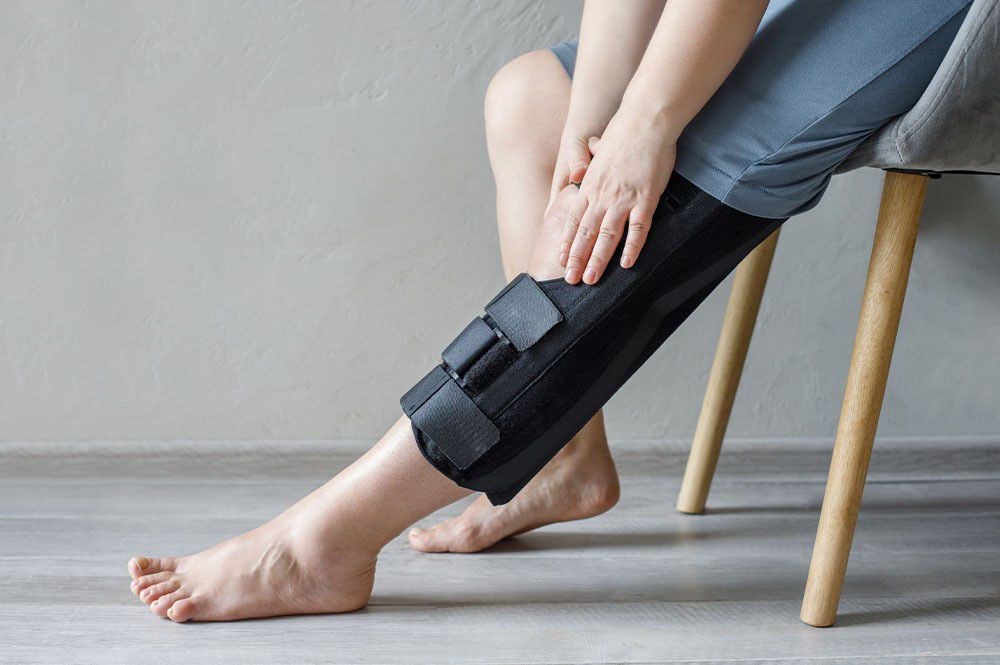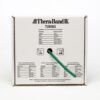Ankle sprain: how to heal it with physiotherapy

- 1 Looking at the situation
- 2 How to distinguish the situation
- 3 Investigation of the accident
- 4 How to cure
- 5 The role of physiotherapy
Risk factors
Vuurberg, in his various publications, described several risk factors and divided them into intrinsic and extrinsic ones.
Intrinsic:
- Limited dorsiflexion ROM
- Decreased proprioception
- Reduced deficits in postural control (positive single-leg balance test)
- BMI (high and/or low, depending on source)
- High medial pressure on the sole of the foot during running
- Reduced strength
- Reduced coordination
- Decreased cardiorespiratory endurance
- Compromised total ankle ROM
- Slowed peroneal reaction time
- Females > males
- Previous ankle injury (although results are mixed)
Extrinsic:
- Sports: basketball, indoor volleyball, field sports, climbing
- Lots of jumping and landing in volleyball
- Playing soccer on natural grass
- Soccer defender
- High heels
- Extrinsic risk, in contrast, is greater for boys than for girls
Ankle sprain: symptoms
After an ankle sprain, immediately or within a few hours, the joint usually swells, and walking is painful. Medical diagnosis is based on a physical examination and, in some cases, an X-ray to rule out bone injuries.
Generally, the injured area is sore and swollen, and sometimes, patients with an ankle sprain experience muscle spasms, an uncontrolled contractions of the muscles around the ankle. The severity of symptoms depends on the severity of the injury. If nerves are also injured, individuals may have difficulty perceiving where their foot and ankle are unless they look at them (loss of proprioceptive sensitivity).
- Mild sprains: strains and small injuries are present in one or more ligaments. The ankle usually feels little pain and hardly swells, but the joint is weakened and at greater risk of injury. Healing can take from a few hours to a few days.
- Moderate to severe sprains: this type of sprain involves a partial ligament injury. The ankle is usually swollen and edematous, and walking is generally painful and challenging. Healing takes days or weeks.
- Very severe sprain: this type of ankle sprain can also involve nerve damage, as well as complete injury to the ligament or multiple ligaments. The entire ankle may be swollen and bruised. The ankle joint is unstable and can no longer carry loads. Healing usually takes 6 to 8 weeks. If you do not wait until the ankle is fully healed before resuming normal activities, the risk of future injury may increase and the healing process of the ankle may be compromised.
In very severe ankle sprains, cartilage breakdown at the end of the bones of the ankle joint may also occur, which can lead to permanent pain, swelling, and sometimes difficulty walking; in addition, the mobility of the joint may be limited or give way uncontrollably. In such cases, one of the possible consequences is that arthritis develops in the joint at a young age.
Sprains often occur when the foot is tilted inward, with the sole facing the other foot (this movement is called “inversion”). This injury usually damages the ligaments located on the outer side of the ankle.
Ankle sprains in which the foot has turned outward (a movement called “eversion”) are less common. When this outward rotation occurs, several additional injuries can occur.
- Avulsion fracture: the ligament that connects the tibia to one of the bones of the foot on the inside of the ankle can tear off a small fragment of the tibia bone. Turning the foot outward is more likely to cause an avulsion fracture than a sprain because the ligament here is very strong.
- Syndesmosis injury: the ligaments that hold the tibia and fibula together at the bottom can be injured.
- Fibula fracture: a fibula fracture can occur in the ankle or sometimes the knee.
- An ankle sprain may also be associated with nerve damage.
When the foot or the ankle tends to rotate outward in certain situations, the risk of sprain increases.
- With loose ligaments in the ankle due to previous sprains,
- with muscle weakness or nerve damage in the leg,
- when wearing certain types of shoes, like ones with stiletto heels.
Diagnosis of ankle sprain
Diagnosing an ankle sprain and its associated damage requires a doctor’s physical examination. It might also sometimes need X-rays to check for fractures or ultrasound scans to check the condition of ligaments and tendons.
The physician investigates the circumstances under which the injury occurred and performs a physical examination. During the examination, the doctor will also move the ankle in different directions to determine the severity of the sprain. However, if the patient has severe pain, swelling, or muscle spasms, the examination is usually postponed until X-rays can be taken and the presence of bone fractures can be checked.
During the examination, the doctor palpates the ankle carefully to determine where the pain is most severe. If touching the skin over a ligament causes severe pain, the ligament is likely torn. If touching the skin over a bone is painful, there may be a fracture. Swelling and spasms make examination of the ankle difficult, and in such cases, doctors may first immobilize the joint with a splint and then examine it again a few days later.
Ankle sprain: therapy
Treatment typically includes RICE (rest, ice, bandage compression, and leg elevation) for mild sprains, immobilization and physical therapy for moderate to severe sprains, and sometimes surgery for very severe sprains. The severity of the sprain depends on which ligaments are injured and how severely they are stretched or torn.
Treatment may also include pain medication and anticoagulants to control pain, edema, and prevention of thrombosis. Crutches are used for all sprains until the affected person can walk normally again.
1. Mild grade sprains
Most ankle sprains are mild, require no special treatment, and heal without sequelae. In this case, the only recommended treatment to follow is RICE. This includes:
- Protection: supporting the ankle with an elastic bandage, splint, specially designed boot, or cast, depending on the severity of the sprain;
- Immobilization: not putting weight on the foot with the injured ankle or only with a crutch if absolutely necessary;
- Ice: application of ice packs on the injured ankle;
- Compression bandage: wrap the ankle and foot with a bandage or elastic tape;
- Elevation: raising the ankle (as often as possible).
Most patients can walk or do physical activity as long as they wear an appropriate brace, shoe, or bandage.
2. Moderate-grade sprains
As mentioned above, sprains can vary in severity. Moderate-grade sprains can also be treated by following the RICE protocol (rest, ice, compression, elevation). If walking becomes extremely difficult, a cast or support such as a boot may be needed. Most patients, in this case, can resume normal physical activities after a few days.
Remember that physical therapy is vital to minimize swelling, maintain the joint’s range of motion, and gradually strengthen the muscles around the ankle to prevent recurrent sprains in the future.
3. Severe sprains
Severe sprains require immediate emergency medical care because, without treatment, they can lead to permanent ankle instability and persistent pain. The ankle is immobilized, sometimes with a cast or brace. Most patients are referred to an orthopedic specialist who will assess the patient and decide how to intervene.
Sometimes, surgery may be considered, but the question of whether it should be performed is controversial. Most experts believe that surgical repair of torn ligaments is not superior to nonsurgical treatment. Physiotherapy exercises, however, play an essential role in restoring mobility, strengthening muscles, and improving balance.
These exercises are necessary before patients can return to physically demanding activities, and at the same time, they promote the healing process.
4. Syndesmosis injuries
High ankle sprains usually require the use of a cast for several weeks.
Ankle sprain: is physical therapy helpful?
If a ligament is injured or torn, strengthening exercises can help stabilize the foot before resuming running.
Most of these exercises aim at muscle strengthening and optimizing coordination. The timing of the start of physical therapy and physiotherapy varies from case to case.
Still, generally, the earlier the physiotherapy course is started, the better and faster the recovery and healing process will be.
However, early initiation of physiotherapy and physical activity probably do not affect the long-term stability of the ankle joint.
An ankle sprain generally resolves automatically and independently, but the physiotherapist’s intervention may accelerate this process.
Physiotherapy treatment
The physiotherapist can then mobilize the joint and ligaments at the initial stage in the directions not involved in the sprain to provide additional rest for the injured part and immediately begin a course of functional reeducation.
During the immobilization period, physiotherapy treatment also serves to control pain and edema, as well as to prevent further complications such as thrombophlebitis and compartmental syndromes. During physiotherapy, the practitioner continues to examine the factors that hinder natural recovery; for example, if the ligaments remain weakened, exercises are performed to strengthen the muscles around the joint and improve coordination so that the muscle component can partially replace the function of the ligaments.
Passive-assisted or active mobilization aims to maintain the mobility of the knee and hip joints, as well as the muscle strength of the muscles connected to them.
Rehabilitation at this stage aims to protect the ankle and ensure a safe and least disabling walking pattern to prevent further problems such as lower back pain, etc. Rehabilitation should preserve the person’s autonomy in their transfers and movements, thus helping to maintain good cardiovascular condition.
In the rehabilitation pathway, various approaches and therapies aimed at recovery and healing are used. These may include:
- 1.Recovery of passive and active mobility (Range Of Movement) of the knee and hip joints and, when possible, extended to the ankle. Specifically:
- passive, active exercises for muscle stabilization and strengthening
- proprioceptive exercises for the hip and knee and partially in ankle unloading
- manual therapy to reduce soft tissue tension
- massage therapy to reduce any edema and soft tissue tension
- diathermy for pain reduction and facilitating recovery of mobility
- laser therapy to reduce pain
- electrostimulation
- taping or kinesio taping.
After immobilization, the physical therapist can begin rehabilitation of the fractured segment following the indications and contraindications prescribed by the physician. Usually, the activity and speed of recovery are dedicated by the patient’s pain level, edema, and local inflammation, which can be reduced and controlled through all physiotherapy tools in the physiotherapist’s possession to help the healing process.
In addition, the patient receives exercise suggestions and instructions for home treatment, emphasizing mobility of the ankle joint, stretching, and strengthening of the anterior and posterior muscles of the leg and foot.
When necessary, the patient can undergo reeducation for walking and going up the stairs, but the most important factor for physical therapy is proprioceptive recovery to avoid the recurrence of the injury that caused the fracture, especially in sports.
Recovery from an ankle sprain takes 3-4 months at most, after which it is possible to return to normal everyday activities and sports.













